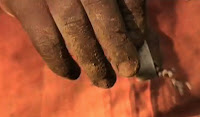Permaculture is the philosophy and practice of sustainable living. This documentary presents the ideology's 14 principles. Agricultural systems are designed to mimic Mother Nature. Subsistence farmers from Kiwangala and Lukindu Villages of Uganda illustrate the film with traditional examples of gardening, conservation, and energy cycling techniques.
The ethics of Permaculture are to care for the land, care for the people, and care for the future using these fourteen principles:
 1. Diversity
1. DiversityPermaculture is a system. The more complex the natural system is the more fluid and productive it becomes. The principle of diversity is interwoven throughout Permaculture.
The most productive pieces of land lie at the edge of two different ecological zones. This is where there is the most diversity. Energy imput and output are highest in these places.
 3. Energy Planning
3. Energy PlanningPermaculture is geared to the idea of working smarter, not necessarily harder. This reduces the wear and tear on the land and the people to ensure future sustenance. A kitchen garden is a good example of Permaculture design. The idea is to create an organic perpetual motion machine.
Nothing in Permaculture is wasted. One system's waste products are used to fuel another system. The feeding/fertilizer cycle is a closed circuit that wastes nothing and requires no outside assistance.
 5. Scale
5. ScaleTop-heavy, overambitious planning can stunt growth rather than promoting development. Start small and build off of what already works, not just what you want to work well. Work off of strengths instead of trying to turn weaknesses into strengths.
Synthetic pesticides are expensive especially in the rural communities of the developing world. They tend to attack the problem narrowly without solving it holistically. If Permaculture is a biological system then ideally it should be maintained biologically.

7. Multiple Elements
Be resourceful. If one part of the system breaks or disappears find ways to continue keeping the system productive. When the cap to this girl's jerrycan went missing, she created a new one out of a banana.

8. Multiple Functions
A chicken is more than just a chicken. Permaculture uses resources to the fullest so that its ecological participants become jacks-of-all-trades.
 9. Natural Succession.
9. Natural Succession.Be in tune with the seasons. There's a time to plant and a time to harvest. These are dependent on wet and dry months. Predicting when the rains will come has been difficult due to recent climate change. This parsley was one of the few plants to survive a recent drought.
There's a man in Japan that is 74 years old and independently maintains 12 acres of some of the most productive farmland in the world. Areas that need the most attention should be kept close at hand. Elements that require less monitoring can be kept further away.
 11. Personal Responsibility
11. Personal ResponsibilityPermanent agriculture sustains for generations upon generations. By planning long term for the future, you ensure through responsible management that there are always enough resources at any present moment in time.
When you interplant vegetable plants among fruit trees you are providing protective shade for young plants. The shorter plants create ground cover and discourage weed growth. It's a symbiotic relationship.
 13. See Solutions Not Problems
13. See Solutions Not ProblemsDon't say, "How do I make this land do what I want it to do?" Instead say, "What can this land provide me with its unique characteristics?" Water takes the shape of whatever vessel it is poured in. How do you adapt to the environment you've been given?

14. Observation
A Permaculturist is just as much a good naturalist. Nature is built up out of different interactions of flora and fauna. These sequences and relationships are rich with diversity. Diversity makes a system fluid and productive.
Highly productive land can be very beautiful.
________________________
_________
This was the last movie I made before leaving Uganda. It came about out of a series of workshops I presented to Peace Corps volunteers. Examples came from the permaculture projects I was working on with the farmers of Kiwangala and Lukindu villages in Masaka, Uganda.
 My interest in permaculture started with appropriate technologies. My Ugandan counterparts taught me how to build tippy-taps, solar driers, firewood saving stoves, and kitchen gardens. These devices are built out of necessity from locally available resources, but show signs of resourceful ingenuity in their simplicity. I became interested in food security, got involved with a demonstration farm and co-op, and drew upon my experiences to develop an agro-education curriculum for the local school. The characters featured in this documentary were my friends and neighbors.
My interest in permaculture started with appropriate technologies. My Ugandan counterparts taught me how to build tippy-taps, solar driers, firewood saving stoves, and kitchen gardens. These devices are built out of necessity from locally available resources, but show signs of resourceful ingenuity in their simplicity. I became interested in food security, got involved with a demonstration farm and co-op, and drew upon my experiences to develop an agro-education curriculum for the local school. The characters featured in this documentary were my friends and neighbors. The 14 principles come from Yayasan Indonesian Development of Education and Permaculture Foundation. IDEP has an excellent permaculture manual that can be downloaded for free. In addition, Bill Mollison, the founder of permaculture, was interviewed in an insightful piece for Mother Earth News. These two sources were great inspiration to my work. The Peace Corps' philosophy of sustainable development was also a major influence.
The 14 principles come from Yayasan Indonesian Development of Education and Permaculture Foundation. IDEP has an excellent permaculture manual that can be downloaded for free. In addition, Bill Mollison, the founder of permaculture, was interviewed in an insightful piece for Mother Earth News. These two sources were great inspiration to my work. The Peace Corps' philosophy of sustainable development was also a major influence.Many ideas for this movie came together while I scribbled in my notebook under this mango tree.






























